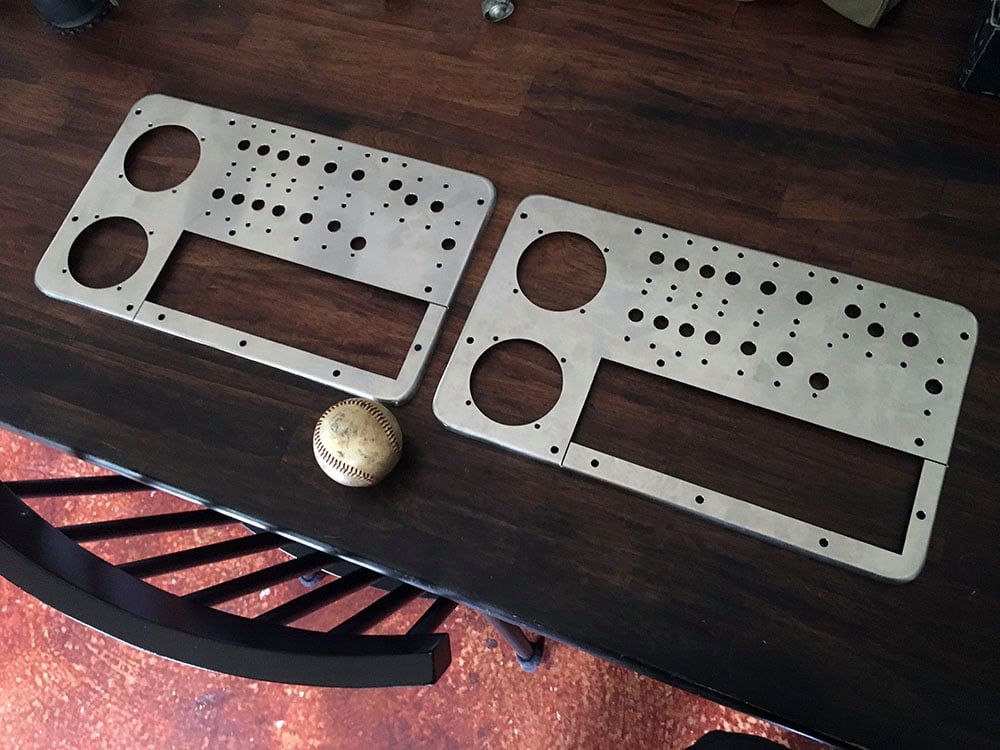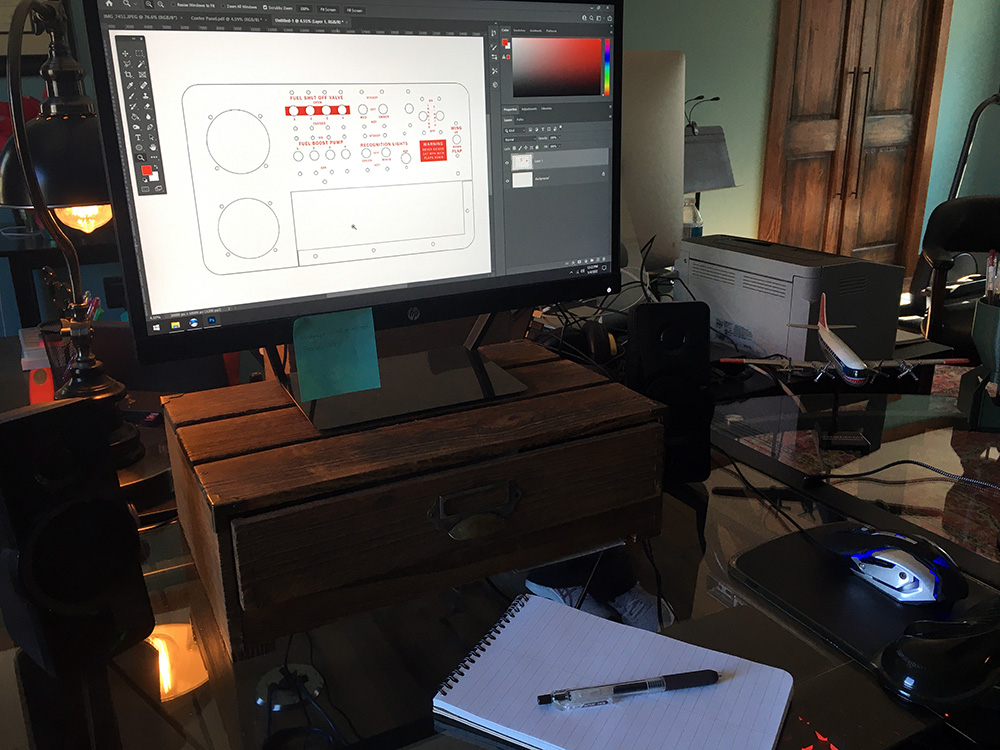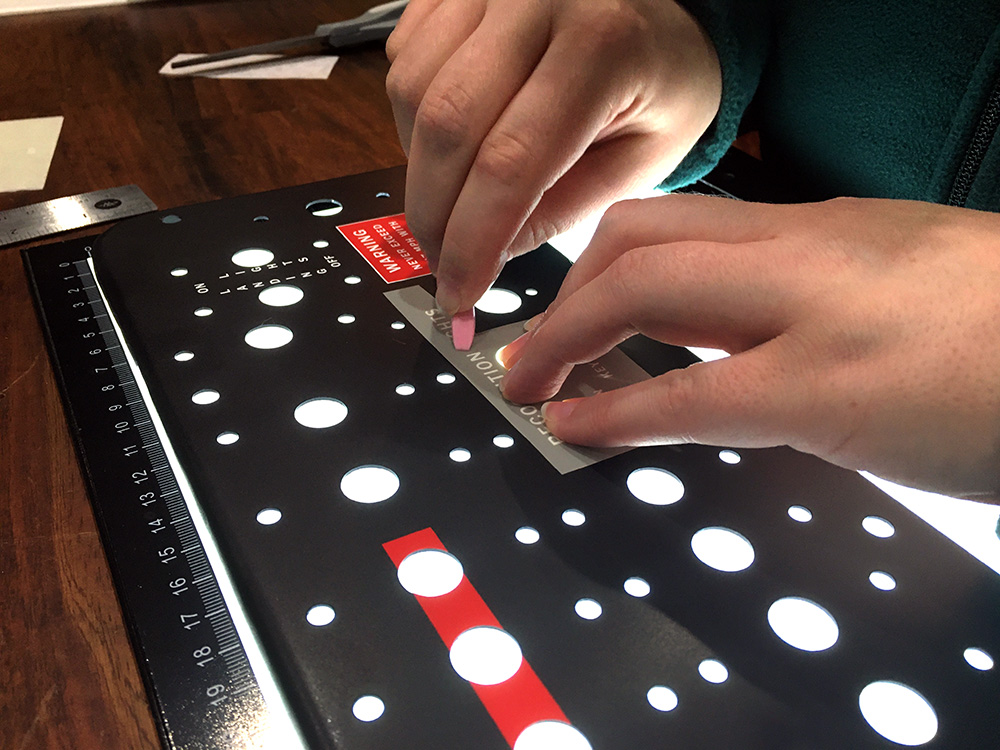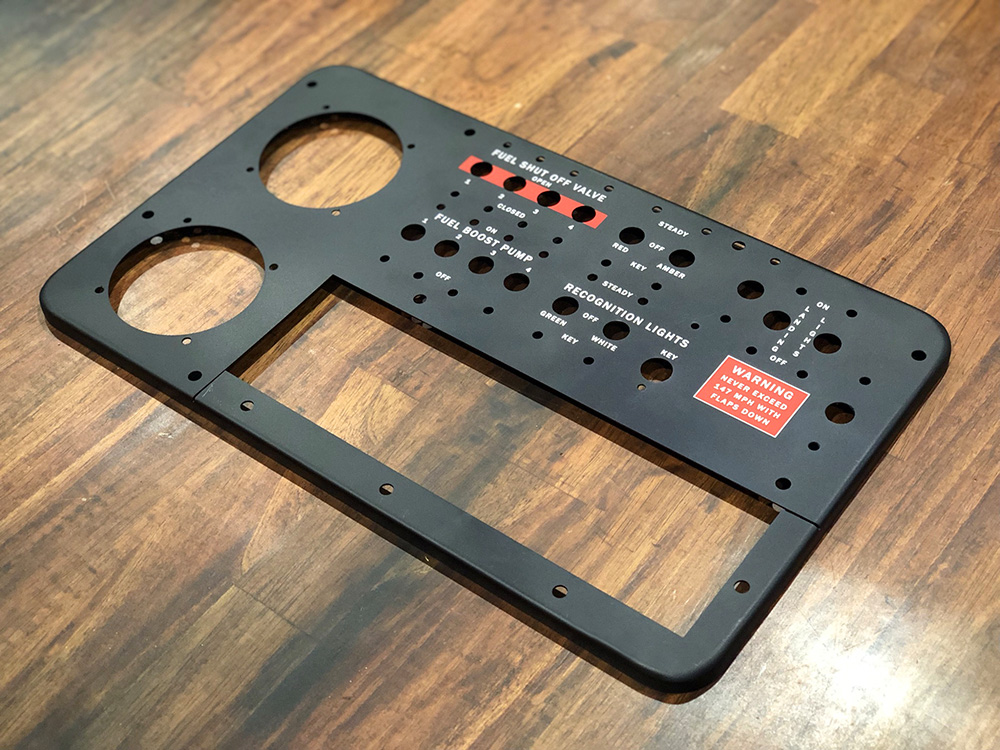
This update is specially dedicated to ReproGraphx Custom Dry Rub-On Transfers. We are immensely thankful for their support as our work could not achieve such a high standard without them.
Whenever one commences a historic project like rebuilding a Boeing B-17F, one must inevitably face decisions on where to draw the line between what is accurate, what is possible, and what is practical. For Hangar Thirteen, we have been absolutely stringent in the former two – we wish to be as accurate as we possibly can. However, there are some practices and materials from the 1940s that are no longer practical or wise. Often these are easy decisions like avoiding things like asbestos and lead-based paints.
Sometimes however, the distinctions are not so clear, the issue not being what is safest, but what is most durable. For example:

Anton’s recreate center console panels, with a baseball for scale.
2021 saw Hangar Thirteen begin an effort to rebuild Lucky Thirteen‘s various instrument panels. A wooden template served as a placeholder for the cockpit main panel while we gathered switches and gauges, and Bob Hachmann began work on its housing. (This project is still underway) It was during this period that Anton Hermans fabricated a beautiful center console panel for us (the panel which held the landing gear, fuel pump, magneto, and cowl flap switches). Being ready for finishing, this latter panel raised questions of practicality, which demanded that we make a decision due to its impact on the larger main panel.
Following Boeing specification, the center panel was originally coated in zinc chromate then painted a particular shade of flat black. However, modern zinc chromates do not adhere as well as wartime ones and we quickly discovered that paint chipping was going to be an issue if we took that approach. Examining original wreckage, we discovered that some panels were anodized rather than painted, and as such, were considerably more damage resistant. We decided to follow this example and Anton’s center panel was anodized by Asheville Metal Finishing, carefully matching the black on Anton’s panel to that of the wartime piece. This proved extremely satisfactory.

But what of the markings? This too is more complex than one might imagine. The original blueprints do not instruct on application as much as they define the finished product – i.e., the approach was not as important as the final result. This meant we had to make a decision regarding the color white. In the printing world, white is not so much a color as it is an absence of color, and because of this, printing white lettering generally means applying color around a white background. This is the method in which many vintage aircraft are restored, printing decals on white paper in an attempt to match black ink to the black paint on an instrument panel, for example. And this method DID see some use during the war.
The problem with this approach is that it is rarely possible to match inks to painted backgrounds, leaving stark differences in color between the background color of the decal and the paint finish of the panel. Several wartime companies accounted for this problem by simply printing giant decals that covered panels in their entirety. Of course, printing gigantic decals is not practical today. But there is another issue. Trying to match the background colors is not really practical as a long-term solution because the inks will undoubtedly fade with age and exposure to sunlight, ultimately negating any color match we might have achieved.

An example of a faded decal on the back of a Silver Eagle tour bus. Originally, the background of this decal was black to match the bus’s paint scheme.
So, what were the alternatives? In wartime, the most common method to apply markings was to have the panels screen printed – an expensive and time-consuming process, generally reserved for manufacturing on an industrial scale. And while white inks do exist, they are often reserved for specially designed printers that are quite rare and out-of-date. Ordinary printers can be altered to accommodate white inks, but these inks are expensive and the results often of questionable quality.
It is for this reason that we turned to ReproGraphx.
ReproGraphx is a provider of custom dry-transfers, printing ink directly onto adhesive backings. The markings are laid out on a sheet of parchment, which is used to align them into place and burnished to apply.

We began by laying out the center console panel on the computer, drawing not only the markings, but the panel itself to ensure proper alignment. Boeing blueprints generally called for American Type Founders Bernhard Gothic, a typeface first created in 1929, allowing for an ‘equivalent’ if the preferred option was unavailable. While we did work to obtain the correct typeface, we noticed some variance in the original wreckage, so some customization was necessary.

Megan applies dry-transfers to the center panel by using a cuticle tool as a burnisher. An artist’s lightpad is below to aid in placement.
This center console panel proved to be an admirable test piece. Once laid out on the computer, the markings were separated by color, requiring different sheets for the white and colored markings, the latter being defined by Pantone color codes. Since the only ink that was applied to the panel was the markings themselves, there are no mismatching of backgrounds. And should the ink ever fade, the markings will do so with the same patina as wartime panels finished via screen printing. Should it become necessary to replace a transfer, the anodization of the metal underneath will allow us to remove the old transfer without damage to the finish below.
We hope to finish out the main cockpit panel this year, who’s markings will be far more ambitious. Panel markings on Second World War aircraft were often phosphorescent or fluorescent, glowing either green or orange (respectfully) in the presence of ultraviolet light. The former was the case for B-17’s main panel and ReproGraphx has already worked with us so to replicate this effect – something impossible with most other approaches. This is truly exciting and we cannot wait to move forward on it.
ReproGraphx’s product has proven to be the best solution to our needs, and our first usage of their work is beautiful beyond words. Photos do not do it justice. We look forward to our continued work with them in rebuilding this giant, four-engine piece of history.
Keep the show on the road!

